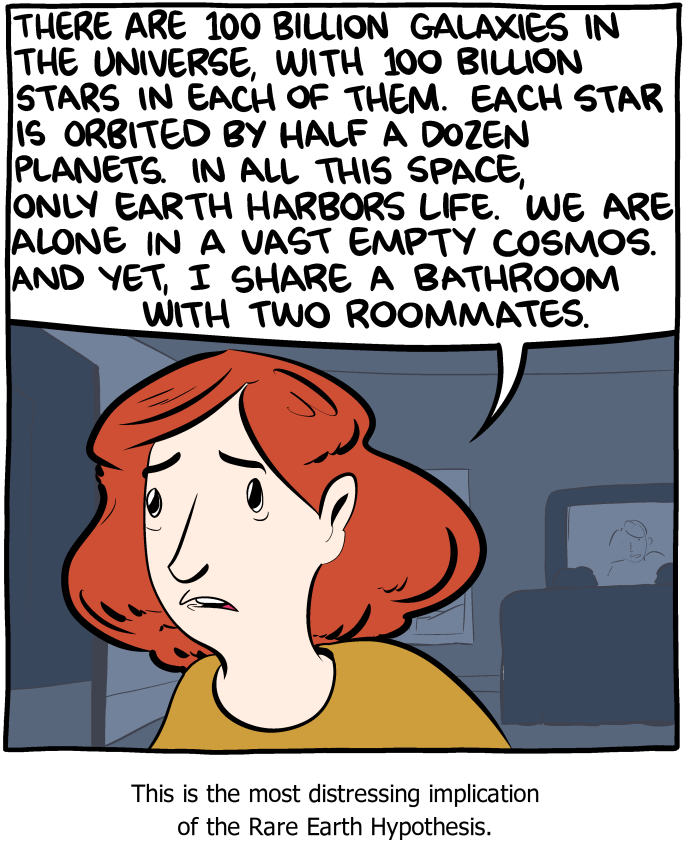I know this comic
is just a joke, but it's from Saturday Morning Breakfast Cereal, a comic that makes lots of jokes about science and which theoretically has its science correct (insofar as the author of the comic makes a point of saying how much he liked studying physics, I guess; he doesn't have much more formal scientific education than I do.)
The "Rare Earth 'Hypothesis'" is supposed to be a rejoinder to "Drake's Equation," which isn't an equation at all; Drake's equation admittedly isn't intended to be mathematical or scientific in nature, but simply to "stimulate talk" on extraterrestrial life. Nonetheless, it was presented by scientists, including Carl Sagan, as an "actual equation." Did that help contribute to the dumbing-down of America? You'll have to decide for yourself. (Hint: Yes.)
In Drake's Equation String of nonsensical variables 'scientists' make a series of assumptions about how many stars there are, how many planets those stars have on average (averages being the most useless measurement of statistics, but the most common), etc etc down to where they come up with 43,000,000,000 potential planets with life on them. It is similar, in scientific rigor, to me doing my budget by saying
There are 100,000 different kinds of jobs in America; on average those jobs pay $200,000 per year, I have worked at 28 jobs in my lifetime, accordingly I have $1,000,000 in the bank.
And then being surprised when my mortgage check bounces. But Drake's Equation was rebutted (!) by the "Rare Earth Hypothesis," which actually made it into a book. Here is the "Rare Earth String of Nonsensical Variables":

"N" is the number of stars in the Milky Way. Even poor excuses for scientists such as the authors of the book this set of assumptions was popularized in admit that the number of stars in the Milky Way is a complete guess; the Wikipedia entry on this 'equation' says the number could be anywhere from 100,000,000 to 500,000,000 -- but even that is a guess.
"My best guess," I told my wife about how much I would earn at my new job, "Is somewhere between 100,000 and 500,000."
Anyway, from there the 'equation' goes on to make other guesses about things we don't know, all in the name of 'science', trying to point out ... something? Apparently it is to show that intelligent life is extremely rare, "intelligent" being defined apparently as "identical to us."
Here's the thing: the nearest earthlike planet we've found is 14 light years away. For that planet alone to have sent us a signal, it would have to have evolved life at or around the same time as us, or at a faster rate than us, because we only in the past 100 years have devised a way to say things to outer space. That planet then would have had to aim its radio waves or light signal in such a way as to hit a tiny target 14 light years away and do so in an manner which we could interpret as a communication.
And those beings would have had to want to do that.
All of these "equations" assume that life on other planets evolved faster than us, or earlier than us, or better than us, and thus have some higher capabilities than us, and they thus ignore the only evidence they have, which is US: if scientists simply said "based on all the evidence we have, it takes about 6,000,000 years for intelligent life capable of sending radio signals to evolve," and then thought about how hard it's even been for us to find earthlike planets in the universe, and then took up the easily-calculable question of what sort of accuracy would be needed to target another planet with a radio wave --
-- something we already know: it wasn't until 1936 that any signal of ours could even get out of Earth's ionosphere, and it would take about 110,000,000 watts of power to get an intelligible signal to the nearest star. Most broadcasts are done at less than 5,000,000 watts, and as pointed out in that link, now that we are using digital TV, and the like, we are becoming less detectable --
if scientists just looked at what we do know and hypothesized from facts the way science is supposed to work, we might actually have made some progress towards communicating with other planets or detecting their communications.
Instead, we wallow around in fake equations and pop 'science' books designed to make money for people rather than be correct or scientific in any way. It's virtually a guarantee that any scientist, doctor or other 'highly educated' person you see on TV or elsewhere in pop culture is about as scientifically rigorous as those charlatans who used to hold seances.

No comments:
Post a Comment